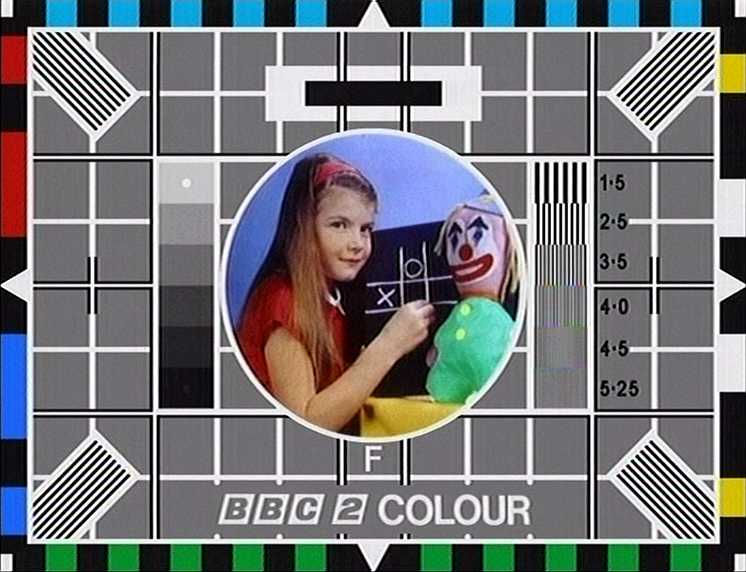Remembering ‘Test Card F’ and Carole Hersee, the ‘test card girl’.

Photo: BBC
Known within the BBC as Test Card F, the iconic image was used on television in the United Kingdom and in countries elsewhere in the world for more than four decades. Like other test cards, it was usually shown while no programs were being broadcast. It was the first to be transmitted in color in the UK and the first to feature a person, becoming an iconic British image regularly subject to parody.
Designed by BBC engineer, George Hersee, the central image on the card shows Hersee’s 8 year-old daughter Carole playing noughts and crosses (i.e. Tic-Tac-Toe or X’s and O’s) with a clown doll, Bubbles the Clown. Surrounded by various greyscales and color test signals used to assess the quality of the transmitted picture, it was first broadcast on 2 July 1967 (the day after the first color pictures appeared to the public on television) on BBC2.
From 1967 to the time it was no longer in regular use, ‘testcardf’ had been shown for an estimated 70,000 hours landing Hersee a ‘Special’ award in 1971 given by Pye TV as the most seen girl on TV for having logged 30 years of telly face time, several hours per day, every single day!
While I never experienced ‘Test Card F’ in real-time, I first became aware of the ‘test card girl’ during the British police procedural, Life on Mars, as the card was in use during the time in 1973 that Sam Tyler ‘woke up’ following a near-fatal car accident. A recurring fictional character of the series, the test card girl continually haunted and intimidated Tyler throughout the series trying to drag him down to hell and away from Gene Hunt’s World as he attempted to either return to 2006 or emerge from a coma.
According to the Life on Mars fan page, Ms Hersee was born on 25 November 1958 and became a costume designer and mother of two. Following school, she became a seamstress at Bermans, the theatrical costumiers, helping to make costumes for the films Julia (1977) and The Lady Vanishes (1979). From May 1979, Hersee worked in the wardrobe department at Shepperton Studios working on costumes for Flash Gordon (1980) and Dangerous Liaisons (1988). Oh, and in case you were wondering, Carole still owns ‘Bubbles’.
#OTD 1967📺The most iconic image, with the advent of colour TV, was called Test Card F.
Depicting BBC engineer’s daughter Carole Hersee (8), with her clown doll Bubbles.
Last broadcast in 1999,Carole can claim to have had more screen time than anyone else in British TV history. pic.twitter.com/e9vdSqOWLg
— ⒷⓇⒾⒻⒻⒶ (@goonerbeau) July 1, 2020
Sadly, in the digital age, while it is one of the best-known test cards ever used, and various versions of it are still in use today, by the BBC and by broadcasters in 30 other countries, Test Card F and its variants are very infrequently broadcast, as downtime in schedules has largely become a thing of the past. Several variations of TCF have been screened, among them Test Card J (digitally enhanced), Test Card W (widescreen) and its HDTV variant, which is sometimes erroneously referred to as Test Card X.
Anyone remember Test Card F?
In: Odds & Sods
